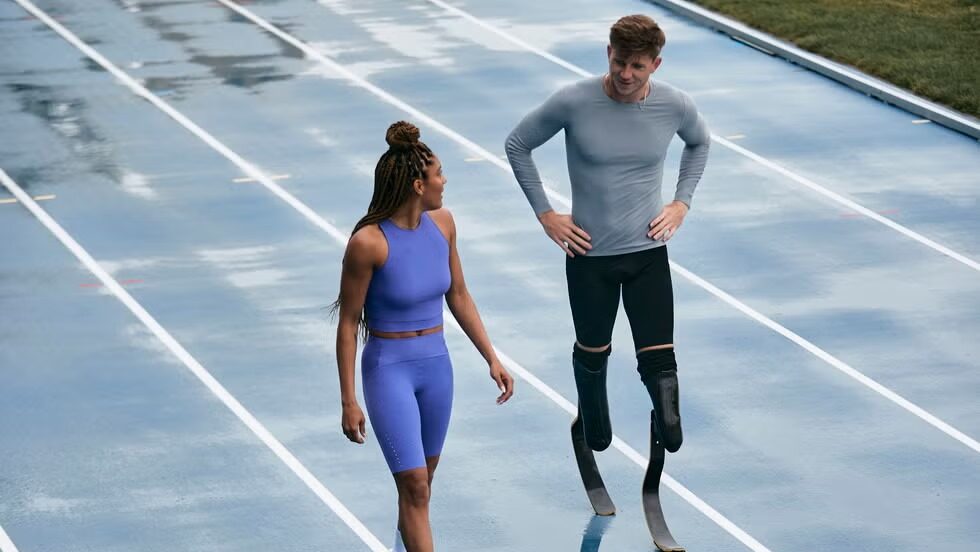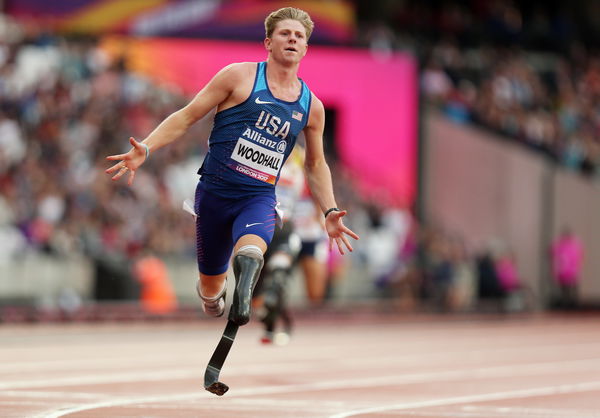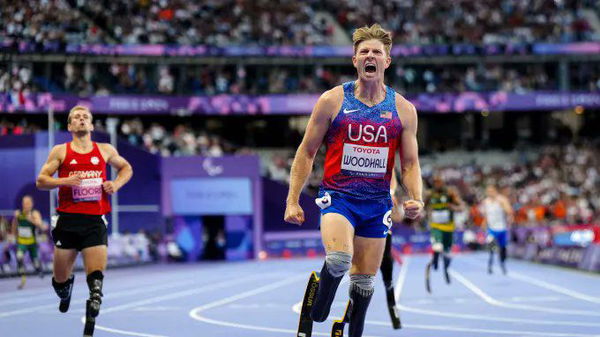

The journey of Hunter Woodhall began with a decision that changed his life before he could even walk. At just 11 months old, doctors amputated both his legs after failed attempts to treat fibular hemimelia, a rare condition where the fibula bone is missing. His parents, Steve and Barb, made the difficult choice after being told his right ankle was fused and that he was missing toes. “It took actually a while to figure out that amputation might be a good solution,” he later admitted. The procedure marked the start of a lifetime navigating prosthetics that, to this day, remain as much a financial burden as they are a physical necessity.
Watch What’s Trending Now!
From his earliest years with artificial limbs, Woodhall learned that his path would never be simple. The Utah native endured bullying at school and once described the experience bluntly. “That was a really tough time for me.” Yet, that hardship eventually transformed into a remarkable athletic career. He became a two-time World Championship medalist and one of the most recognizable Paralympians in the United States. But his greatest hurdle has not come on the track. It comes from the staggering price of the very equipment that makes his career possible.
Speaking recently on the Tidal League podcast with Justin Gatlin and Rodney Green, Woodhall explained that the cost of prosthetic technology rivals luxury cars. Green, who once coached para athletes, recalled a conversation with a competitor who pointed to his artificial limbs and said, “That’s a Porsche over there.” Woodhall immediately agreed. “He’s not lying. So those dude I mean, it’s so expensive. It’s so expensive.” For many Paralympians, replacing a single electronic knee can reach six figures. “It can be 100 grand for a knee. Like all in. So you got a 488 on your leg.”
ADVERTISEMENT
The irony, as Woodhall explained, is that these devices were long excluded from insurance coverage. “In the past, it hasn’t been covered by insurance at all because it’s not seen as a necessity. It’s seen as like a luxury.” That classification, he argued, has forced many disabled athletes into an impossible financial corner. His own state of Arkansas recently passed a bill requiring insurance to cover secondary prosthetics, thanks in part to his collaboration with his prosthetist, France Vanderwatt. “Now other states are following,” he mentioned, though much of the country still lags behind.

Imago
Mandatory Credit: Photo by James Marsh/BPI/Shutterstock 8971236bs Hunter Woodhall of USA crosses the line to win gold for his team in the Mens 4x100m Relay T42-47. World Para Athletics Championships 2017, Day Ten, London Stadium, London, UK, 23 July 2017 World Para Athletics Championships 2017, Day Ten, London Stadium, London, UK, 23 July 2017 PUBLICATIONxINxGERxSUIxAUTXHUNxGRExMLTxCYPxROMxBULxUAExKSAxONLY Copyright: xJamesxMarsh/BPI/Shutterstockx 8971236bs
Even the smallest items carry inflated costs. A single prosthetic sock, necessary for daily use, can run $30 to $60. “Not anymore because Nike made some prosthetic socks, but the normal ones that are made by the medical companies, like one sock is like $30 to $60,” he shared. His wife, Olympic long jumper Tara Davis-Woodhall, added that he must wear “four, five socks every single day,” with constant laundry cycles just to keep up. For an elite athlete, the daily wear and tear is immense, with training alone capable of burning through ten socks in a day.
ADVERTISEMENT
For Woodhall, the financial strain is inseparable from the reality of disability. “That’s just part of having a disability… like people with disabilities like there’s so much stuff they got to deal with just getting out of bed and living a normal life.” It is this contrast—between public celebration of Paralympic achievement and the private burden of equipment costs—that shapes his frustration. As he put it plainly, being a Paralympian in the United States can feel more difficult than buying a Porsche.
But undoubtedly, with the aid of his prosthetic blades, Hunter Woodhall transformed adversity into speed, rising toward the pinnacle of Paralympic sport.
ADVERTISEMENT
Hunter Woodhall’s blades carry him closer to Olympic gold
Hunter Woodhall’s story is one of steady progress, guided as much by resolve as by the technology that enabled him to race. His prosthetic blades were never presented as a substitute for what he lost, but rather as tools that allowed him to carve a place within one of sport’s most competitive arenas. From his first international medals, he began to recognize the scale of what was possible.
“Man, I could be really good at this,” he remarked during those early seasons, and the evidence on the track quickly confirmed that impression.
ADVERTISEMENT

ADVERTISEMENT
What followed was a career shaped by discipline and a refusal to accept limitation.
In Rio, he gathered silver and bronze medals, proof that his training had lifted him among the finest in his field. By the time Tokyo arrived, he had already adjusted his stride to new classifications and emerged with a bronze in the 400m T62. Each race, each adjustment to equipment or training methods, reinforced a central fact: The prosthetics were not obstacles but extensions of his pursuit. His performances did not stand apart from the wider track community, but within it, earning respect and recognition alongside able-bodied contemporaries.
As he matured, his ambitions sharpened.
At the 2024 World Championships, he secured silver medals in both sprint and quarter-mile contests. After running 46.9 seconds at the U.S. trials, Paris presented itself as the logical next step, the place where gold might finally be seized. In his own words, “World championships can change your career, but the Olympics can change your life.” And finally, in the 2024 Paralympic Games, he secured Gold in the 400-meter T62 final.
For Woodhall, whose life has long been framed by the challenge of running on blades, the pursuit of that Olympic gold now stands as both culmination and new beginning.
ADVERTISEMENT
ADVERTISEMENT
ADVERTISEMENT

